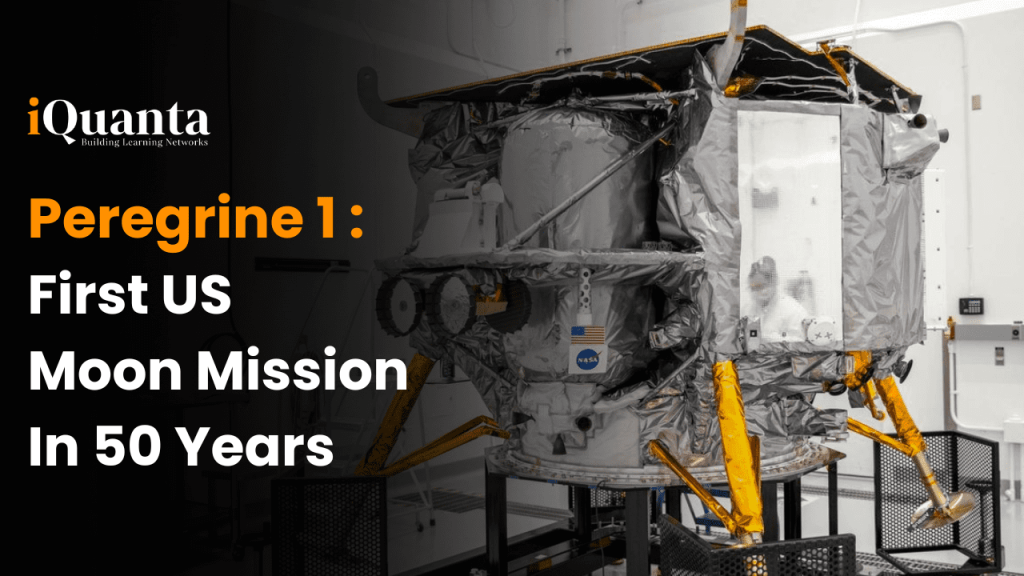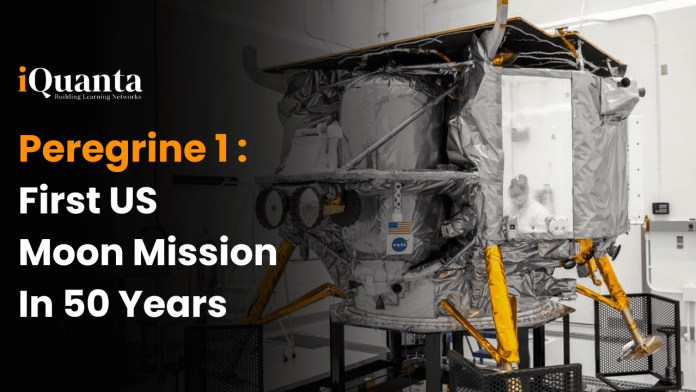
Genre : Science
The Peregrine Lunar Lander, or NASA Peregrine 1 mission, has launched successfully. NASA’s first moon landing mission since the Apollo program is this one. On January 8, 2024, at 2:18 am EST (12:48 pm IST), a Vulcan Centaur launch vehicle provided by United Launch Alliance (ULA) was launched from Cape Canaveral, Florida.
Delivering scientific and technical payloads to the Moon is the goal of Peregrine Mission One. The lander has a total mass capacity of 90 kg for its various payloads. The mission’s scientific goals include investigating the lunar exosphere, magnetic fields, radiation environment, thermal characteristics, and hydrogen abundance of the lunar regolith. The mission will also test cutting-edge solar panels.
The Peregrine lander is scheduled to touch down on February 23 at Sinus Viscositatis, a lunar feature situated outside the lava hardened Gruithuisen Domes on the Moon’s near side. Because analogous natural structures on Earth require vast amounts of water to produce, scientists think that evidence of water may be present at this landing site, which makes it more interesting.

Peregrine 1: An Amazing Technological feat
Peregrine 1 is a single-stage robotic lander built by Pittsburgh-based Astrobotic with the goal of delivering payloads to the Moon. Standing 16 meters tall and weighing five tons, it has a number of cutting-edge features, such as:
- There are three primary engines that supply thrust for the Moon’s ascent, descent, and launch.
- Autonomous landing system: Peregrine can navigate and land accurately on the lunar surface thanks to sophisticated sensors and algorithms.
- Payload capacity: Up to 330 kg of scientific equipment, technological demonstrations, and commercial payloads can be accommodated by the lander.
The mission carries a suite of payloads provided by NASA. These payloads include:
- LET’S (Linear Energy Transfer Spectrometer): A radiation monitor designed to show off the capabilities of radiation monitors on the lunar surface while gathering data on the radiation environment there.
- NIRVSS (Near-Infrared Volatile Spectrometer System): The composition, surface temperature, and fine-scale structure of the lunar soil at the landing site will be made public by this cargo. It will investigate the lunar soil and look for volatiles and minerals.
- NSS (Neutron Spectrometer System): At the landing site, this device will obliquely identify any possible water in the lunar soil. Over the course of a lunar day, it will measure any variations in the properties of the lunar soil.
- PITMS (Peregrine Ion-Trap Mass Spectrometer): After landing and descent, this payload will examine the composition of chemicals in the thin lunar atmosphere. It will make it easier to comprehend how volatile substances like water, gasses, and other chemical components move and release energy.
- LRA (Laser Retroreflector Array): The eight retroreflectors in this group will allow accurate distance measurements between the lander and the orbiting or landing spacecraft. It will serve as a long-term marker of its location on the moon.
These payloads will provide valuable data to enhance our understanding of the lunar environment and support future missions to the Moon.
Significance
Commercial collaboration: It shows that private enterprises may successfully lead lunar missions, possibly lowering costs and boosting mission frequency.
Scientific advances: The varied payloads will provide insightful information that will deepen our knowledge of the Moon and its possible resources.
Technological innovation: By pushing the limits of autonomous operations and spacecraft architecture, the mission paves the path for robotic and human lunar missions in the future.
Challenges
Even though Peregrine 1 is a significant accomplishment, lunar exploration is still a difficult and complex undertaking. Among the difficulties are:
- Extreme heat, radiation, and dust on the Moon can be quite dangerous for spacecraft and instrumentation. This is a harsh lunar environment.
- Unexpected technical difficulties: There is always a chance that a moon trip would encounter difficulties, thus preparedness and fast thinking are essential.
- Sustainable lunar activities: Resource extraction, waste management, and radiation protection must all be taken care of in order to establish a long-term presence on the moon.
The accomplishments of Peregrine 1 give hope for the future of lunar exploration in spite of these difficulties. A new era of lunar exploration and possibly even human missions is ushered in by this mission, which is a monument to the creativity and cooperation of NASA and private enterprises.

